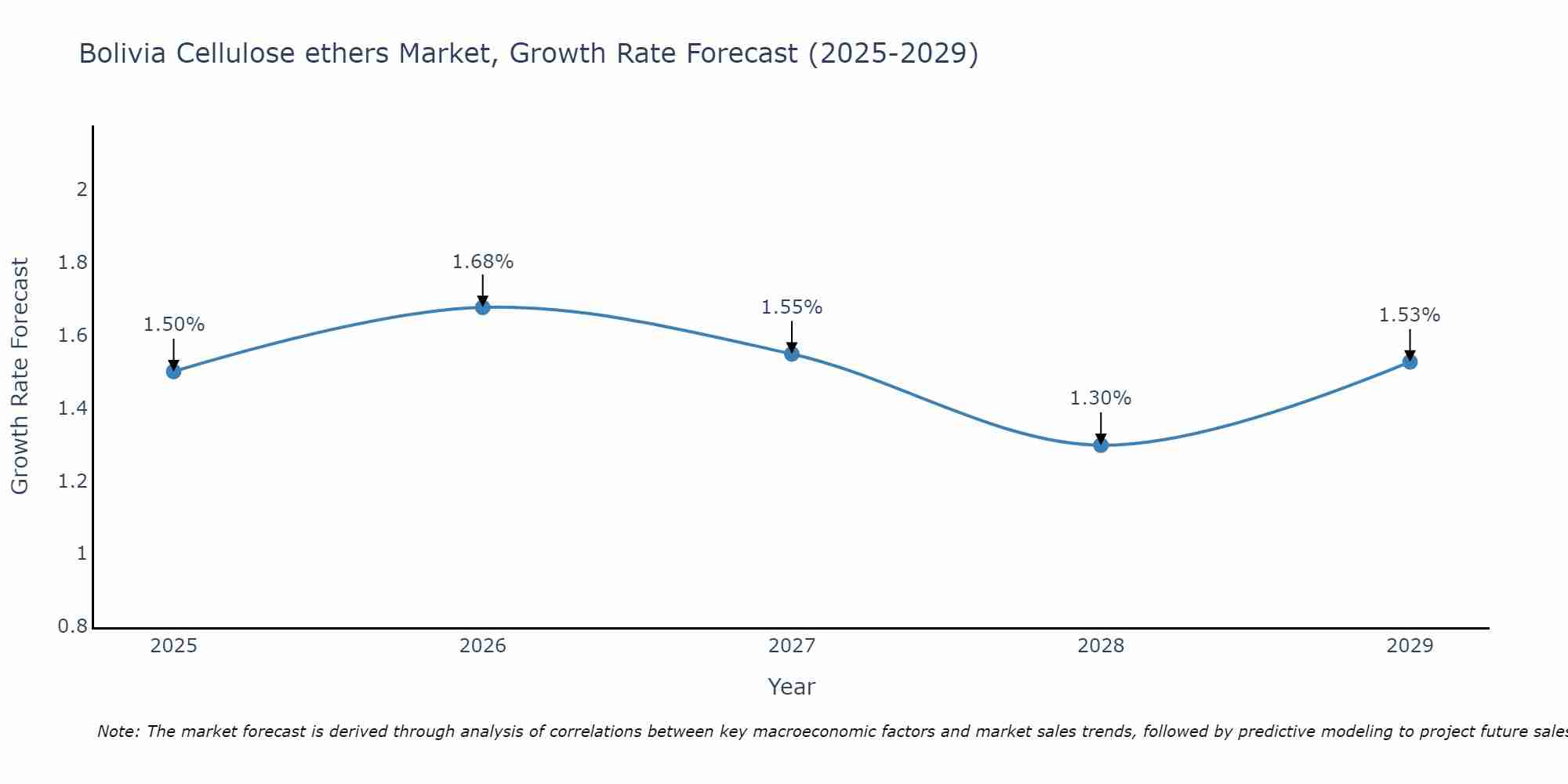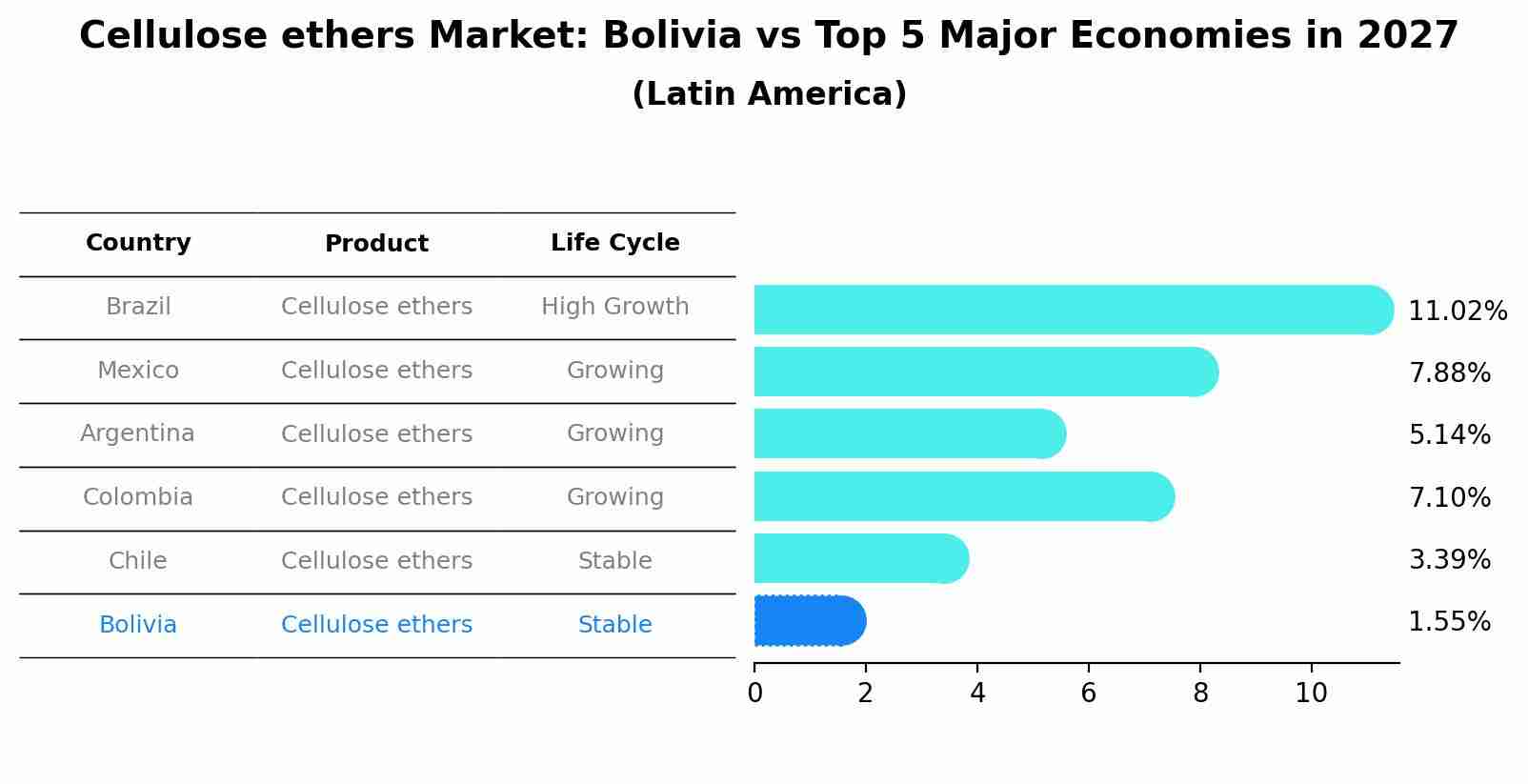Bolivia Cellulose ethers Market (2025-2031) | Trends, Forecast, Revenue, Industry, Value, Segmentation, Companies, Share, Growth, Analysis, Outlook & Size
| Product Code: ETC4704217 | Publication Date: Nov 2023 | Updated Date: Sep 2025 | Product Type: Market Research Report | |
| Publisher: 6Wresearch | Author: Shubham Deep | No. of Pages: 60 | No. of Figures: 30 | No. of Tables: 5 |
Bolivia Cellulose ethers Market Size Growth Rate
The Bolivia Cellulose ethers Market is projected to witness mixed growth rate patterns during 2025 to 2029. Growth accelerates to 1.68% in 2026, following an initial rate of 1.50%, before easing to 1.53% at the end of the period.

Cellulose ethers Market: Bolivia vs Top 5 Major Economies in 2027 (Latin America)
By 2027, Bolivia's Cellulose ethers market is forecasted to achieve a stable growth rate of 1.55%, with Brazil leading the Latin America region, followed by Mexico, Argentina, Colombia and Chile.

Bolivia Cellulose ethers Market Overview
Bolivia`s cellulose ethers market is expanding, with applications in pharmaceuticals, construction, and food products. Cellulose ethers are used for their thickening, stabilizing, and emulsifying properties, driving demand in key industries.
Drivers of the market
The Bolivia cellulose ethers market is driven by their use as thickeners, stabilizers, and emulsifiers in various industries, including food and beverage, pharmaceuticals, and construction. The demand for natural and multifunctional ingredients further supports market growth.
Challenges of the market
The cellulose ethers market in Bolivia is challenged by fluctuating raw material prices and the need for effective application in various industrial processes. Cellulose ethers are used as thickeners and stabilizers in various products, but the market must address issues such as production costs, competition from alternative additives, and regulatory requirements.
Government Policy of the market
The cellulose ethers market in Bolivia is subject to regulations that ensure the safety and effectiveness of cellulose ether products. The government imposes standards for the quality and performance of cellulose ethers used in various industries, including construction and pharmaceuticals. Import regulations require compliance with local standards, and policies support the growth of the local cellulose ethers industry.
Key Highlights of the Report:
- Bolivia Cellulose ethers Market Outlook
- Market Size of Bolivia Cellulose ethers Market, 2024
- Forecast of Bolivia Cellulose ethers Market, 2031
- Historical Data and Forecast of Bolivia Cellulose ethers Revenues & Volume for the Period 2021-2031
- Bolivia Cellulose ethers Market Trend Evolution
- Bolivia Cellulose ethers Market Drivers and Challenges
- Bolivia Cellulose ethers Price Trends
- Bolivia Cellulose ethers Porter`s Five Forces
- Bolivia Cellulose ethers Industry Life Cycle
- Historical Data and Forecast of Bolivia Cellulose ethers Market Revenues & Volume By Product Type for the Period 2021-2031
- Historical Data and Forecast of Bolivia Cellulose ethers Market Revenues & Volume By Carboxymethyl Cellulose for the Period 2021-2031
- Historical Data and Forecast of Bolivia Cellulose ethers Market Revenues & Volume By Methyl Cellulose & Derivatives for the Period 2021-2031
- Historical Data and Forecast of Bolivia Cellulose ethers Market Revenues & Volume By Hydroxyethyl Cellulose for the Period 2021-2031
- Historical Data and Forecast of Bolivia Cellulose ethers Market Revenues & Volume By Others for the Period 2021-2031
- Historical Data and Forecast of Bolivia Cellulose ethers Market Revenues & Volume By Application for the Period 2021-2031
- Historical Data and Forecast of Bolivia Cellulose ethers Market Revenues & Volume By Food and Beverage for the Period 2021-2031
- Historical Data and Forecast of Bolivia Cellulose ethers Market Revenues & Volume By Pharmaceuticals and Healthcare for the Period 2021-2031
- Historical Data and Forecast of Bolivia Cellulose ethers Market Revenues & Volume By Construction for the Period 2021-2031
- Historical Data and Forecast of Bolivia Cellulose ethers Market Revenues & Volume By Cosmetics for the Period 2021-2031
- Historical Data and Forecast of Bolivia Cellulose ethers Market Revenues & Volume By Personal Care for the Period 2021-2031
- Historical Data and Forecast of Bolivia Cellulose ethers Market Revenues & Volume By Others for the Period 2021-2031
- Bolivia Cellulose ethers Import Export Trade Statistics
- Market Opportunity Assessment By Product Type
- Market Opportunity Assessment By Application
- Bolivia Cellulose ethers Top Companies Market Share
- Bolivia Cellulose ethers Competitive Benchmarking By Technical and Operational Parameters
- Bolivia Cellulose ethers Company Profiles
- Bolivia Cellulose ethers Key Strategic Recommendations
Frequently Asked Questions About the Market Study (FAQs):
1 Executive Summary |
2 Introduction |
2.1 Key Highlights of the Report |
2.2 Report Description |
2.3 Market Scope & Segmentation |
2.4 Research Methodology |
2.5 Assumptions |
3 Bolivia Cellulose ethers Market Overview |
3.1 Bolivia Country Macro Economic Indicators |
3.2 Bolivia Cellulose ethers Market Revenues & Volume, 2021 & 2031F |
3.3 Bolivia Cellulose ethers Market - Industry Life Cycle |
3.4 Bolivia Cellulose ethers Market - Porter's Five Forces |
3.5 Bolivia Cellulose ethers Market Revenues & Volume Share, By Product Type, 2021 & 2031F |
3.6 Bolivia Cellulose ethers Market Revenues & Volume Share, By Application, 2021 & 2031F |
4 Bolivia Cellulose ethers Market Dynamics |
4.1 Impact Analysis |
4.2 Market Drivers |
4.2.1 Increasing demand for eco-friendly and sustainable products in various industries, such as construction, pharmaceuticals, and food beverages. |
4.2.2 Growing awareness about the benefits of cellulose ethers in enhancing product performance and reducing environmental impact. |
4.2.3 Favorable government regulations promoting the use of cellulose ethers in different applications. |
4.3 Market Restraints |
4.3.1 Fluctuations in raw material prices, such as wood pulp, which can impact the production cost of cellulose ethers. |
4.3.2 Limited availability of skilled labor for the manufacturing and application of cellulose ethers. |
4.3.3 Volatility in global economic conditions affecting the overall market demand and investments in new projects. |
5 Bolivia Cellulose ethers Market Trends |
6 Bolivia Cellulose ethers Market Segmentations |
6.1 Bolivia Cellulose ethers Market, By Product Type |
6.1.1 Overview and Analysis |
6.1.2 Bolivia Cellulose ethers Market Revenues & Volume, By Carboxymethyl Cellulose, 2021-2031F |
6.1.3 Bolivia Cellulose ethers Market Revenues & Volume, By Methyl Cellulose & Derivatives, 2021-2031F |
6.1.4 Bolivia Cellulose ethers Market Revenues & Volume, By Hydroxyethyl Cellulose, 2021-2031F |
6.1.5 Bolivia Cellulose ethers Market Revenues & Volume, By Others, 2021-2031F |
6.2 Bolivia Cellulose ethers Market, By Application |
6.2.1 Overview and Analysis |
6.2.2 Bolivia Cellulose ethers Market Revenues & Volume, By Food and Beverage, 2021-2031F |
6.2.3 Bolivia Cellulose ethers Market Revenues & Volume, By Pharmaceuticals and Healthcare, 2021-2031F |
6.2.4 Bolivia Cellulose ethers Market Revenues & Volume, By Construction, 2021-2031F |
6.2.5 Bolivia Cellulose ethers Market Revenues & Volume, By Cosmetics, 2021-2031F |
6.2.6 Bolivia Cellulose ethers Market Revenues & Volume, By Personal Care, 2021-2031F |
6.2.7 Bolivia Cellulose ethers Market Revenues & Volume, By Others, 2021-2031F |
7 Bolivia Cellulose ethers Market Import-Export Trade Statistics |
7.1 Bolivia Cellulose ethers Market Export to Major Countries |
7.2 Bolivia Cellulose ethers Market Imports from Major Countries |
8 Bolivia Cellulose ethers Market Key Performance Indicators |
8.1 Research and development investment in new cellulose ethers formulations and applications. |
8.2 Number of collaborations and partnerships with key industry players for market expansion. |
8.3 Adoption rate of cellulose ethers in new end-use applications. |
8.4 Environmental impact assessments and sustainability certifications for cellulose ethers production processes. |
8.5 Regulatory compliance and adherence to quality standards in the manufacturing of cellulose ethers. |
9 Bolivia Cellulose ethers Market - Opportunity Assessment |
9.1 Bolivia Cellulose ethers Market Opportunity Assessment, By Product Type, 2021 & 2031F |
9.2 Bolivia Cellulose ethers Market Opportunity Assessment, By Application, 2021 & 2031F |
10 Bolivia Cellulose ethers Market - Competitive Landscape |
10.1 Bolivia Cellulose ethers Market Revenue Share, By Companies, 2024 |
10.2 Bolivia Cellulose ethers Market Competitive Benchmarking, By Operating and Technical Parameters |
11 Company Profiles |
12 Recommendations | 13 Disclaimer |
- Single User License$ 1,995
- Department License$ 2,400
- Site License$ 3,120
- Global License$ 3,795
Search
Related Reports
- Uganda Excavator, Crane, and Wheel Loaders Market (2025-2031) | Strategy, Consumer Insights, Analysis, Investment Trends, Opportunities, Growth, Size, Share, Industry, Revenue, Segments, Value, Segmentation, Supply, Forecast, Restraints, Outlook, Competition, Drivers, Trends, Demand, Pricing Analysis, Competitive, Strategic Insights, Companies, Challenges
- Rwanda Excavator, Crane, and Wheel Loaders Market (2025-2031) | Strategy, Consumer Insights, Analysis, Investment Trends, Opportunities, Growth, Size, Share, Industry, Revenue, Segments, Value, Segmentation, Supply, Forecast, Restraints, Outlook, Competition, Drivers, Trends, Demand, Pricing Analysis, Competitive, Strategic Insights, Companies, Challenges
- Kenya Excavator, Crane, and Wheel Loaders Market (2025-2031) | Strategy, Consumer Insights, Analysis, Investment Trends, Opportunities, Growth, Size, Share, Industry, Revenue, Segments, Value, Segmentation, Supply, Forecast, Restraints, Outlook, Competition, Drivers, Trends, Demand, Pricing Analysis, Competitive, Strategic Insights, Companies, Challenges
- Angola Excavator, Crane, and Wheel Loaders Market (2025-2031) | Strategy, Consumer Insights, Analysis, Investment Trends, Opportunities, Growth, Size, Share, Industry, Revenue, Segments, Value, Segmentation, Supply, Forecast, Restraints, Outlook, Competition, Drivers, Trends, Demand, Pricing Analysis, Competitive, Strategic Insights, Companies, Challenges
- Israel Intelligent Transport System Market (2025-2031) | Strategy, Consumer Insights, Analysis, Investment Trends, Opportunities, Growth, Size, Share, Industry, Revenue, Segments, Value, Segmentation, Supply, Forecast, Restraints, Outlook, Competition, Drivers, Trends, Demand, Pricing Analysis, Competitive, Strategic Insights, Companies, Challenges
- Uganda Precast and Aggregate Market (2025-2031) | Strategy, Consumer Insights, Analysis, Investment Trends, Opportunities, Growth, Size, Share, Industry, Revenue, Segments, Value, Segmentation, Supply, Forecast, Restraints, Outlook, Competition, Drivers, Trends, Demand, Pricing Analysis, Competitive, Strategic Insights, Companies, Challenges
- Australia IT Asset Disposal Market (2025-2031) | Strategy, Consumer Insights, Analysis, Investment Trends, Opportunities, Growth, Size, Share, Industry, Revenue, Segments, Value, Segmentation, Supply, Forecast, Restraints, Outlook, Competition, Drivers, Trends, Demand, Pricing Analysis, Competitive, Strategic Insights, Companies, Challenges
- UAE Building Thermal Insulation Market Outlook (2025-2031) | Revenue, Companies, Share, Trends, Growth, Size, Forecast, Industry, Analysis & Value
- Portugal Electronic Document Management Market (2025-2031) | Strategy, Consumer Insights, Analysis, Investment Trends, Opportunities, Growth, Size, Share, Industry, Revenue, Segments, Value, Segmentation, Supply, Forecast, Restraints, Outlook, Competition, Drivers, Trends, Demand, Pricing Analysis, Competitive, Strategic Insights, Companies, Challenges
- France Electronic Document Management Market (2025-2031) | Strategy, Consumer Insights, Analysis, Investment Trends, Opportunities, Growth, Size, Share, Industry, Revenue, Segments, Value, Segmentation, Supply, Forecast, Restraints, Outlook, Competition, Drivers, Trends, Demand, Pricing Analysis, Competitive, Strategic Insights, Companies, Challenges
Industry Events and Analyst Meet
Our Clients
Whitepaper
- Middle East & Africa Commercial Security Market Click here to view more.
- Middle East & Africa Fire Safety Systems & Equipment Market Click here to view more.
- GCC Drone Market Click here to view more.
- Middle East Lighting Fixture Market Click here to view more.
- GCC Physical & Perimeter Security Market Click here to view more.
6WResearch In News
- Doha a strategic location for EV manufacturing hub: IPA Qatar
- Demand for luxury TVs surging in the GCC, says Samsung
- Empowering Growth: The Thriving Journey of Bangladesh’s Cable Industry
- Demand for luxury TVs surging in the GCC, says Samsung
- Video call with a traditional healer? Once unthinkable, it’s now common in South Africa
- Intelligent Buildings To Smooth GCC’s Path To Net Zero













